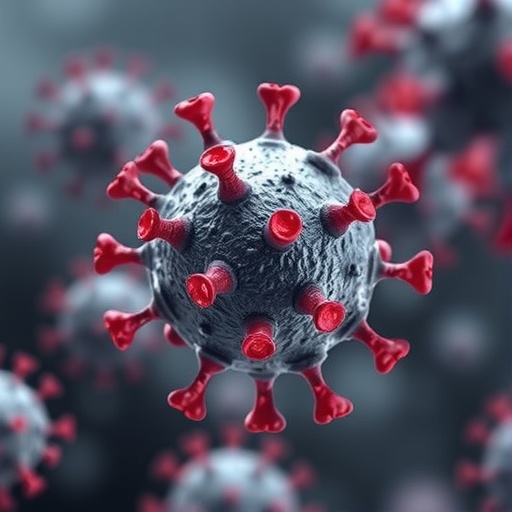In a groundbreaking study recently published in npj Viruses, a team of researchers led by Halfmann and colleagues has unveiled promising new insights into vaccine design against Merbecoviruses, a subgenus of coronaviruses that includes the Middle East Respiratory Syndrome coronavirus (MERS-CoV). Their work focuses on the S2 subunit of the spike (S) glycoprotein, a component that has drawn increasing attention as a target for broadly reactive vaccines capable of eliciting cross-protective immunity across diverse members of this viral lineage. This study not only provides compelling evidence that S2 subunit vaccines can generate cross-reactive antibodies but also shows that they afford partial protection in animal models against MERS-CoV challenge, marking a significant step forward in the fight against this often deadly virus.
Coronaviruses have been in the global spotlight since the outbreak of SARS-CoV-2, but MERS-CoV remains a formidable threat, with mortality rates exceeding 30%. Unlike SARS-CoV-2, which has spread globally, MERS outbreaks have been largely restricted to the Middle East, though sporadic cases have appeared worldwide, underscoring the necessity for effective vaccines. While existing vaccine candidates have primarily targeted the receptor-binding domain (RBD) within the S1 subunit of the spike protein, these regions tend to be highly variable among different coronaviruses and even among variants of a single virus. The S2 domain, however, is conserved across Merbecoviruses and related coronaviruses, making it an attractive target for a universal vaccine approach.
The spike protein, a trimeric glycoprotein protruding from the viral envelope, facilitates the entry of coronaviruses into host cells through receptor recognition and membrane fusion. The S1 subunit mediates binding to host receptors such as dipeptidyl peptidase 4 (DPP4) in MERS-CoV, whereas the S2 subunit promotes the fusion of viral and cellular membranes, a crucial step for viral entry. While the S1 domain elicits robust neutralizing antibody responses, its high immunological variability can limit vaccine breadth. Targeting the more conserved S2 subunit could overcome this hurdle by inducing antibodies that neutralize a wider spectrum of Merbecoviruses, reducing the chances of immune escape.
.adsslot_MD1BSg6pdf{ width:728px !important; height:90px !important; }
@media (max-width:1199px) { .adsslot_MD1BSg6pdf{ width:468px !important; height:60px !important; } }
@media (max-width:767px) { .adsslot_MD1BSg6pdf{ width:320px !important; height:50px !important; } }
ADVERTISEMENT
In the study, the researchers engineered a vaccine based on the S2 subunit of MERS-CoV spike protein and evaluated its immunogenicity and protective efficacy in murine models. They observed that vaccination with the S2 subunit elicited antibodies not only reactive to MERS-CoV but also cross-reactive with spike proteins from related Merbecoviruses, indicating broad immunity potential. Remarkably, these antibodies were capable of neutralizing viral entry in vitro, supporting their functional relevance. The vaccinated mice showed reduced viral loads following MERS-CoV challenge, confirming that S2-targeted immunity can confer partial protection against infection.
One of the key technical achievements of this work was stabilizing the S2 subunit in a prefusion conformation, which is crucial for maintaining its structural epitopes recognizable by the immune system. Prior efforts had been hindered by the metastable nature of the spike protein and its subunits, leading to conformational changes that can mask neutralizing epitopes. By employing protein engineering techniques, including proline substitutions and furin cleavage site alteration, the team preserved the antigen’s native structure, thereby enhancing its immunogenicity.
Serological analyses revealed that the S2 vaccine induced a broad repertoire of immunoglobulin G (IgG) antibodies with high avidity, suggesting strong and durable immune responses. Importantly, the antibodies showed cross-reactivity toward spike proteins of other Merbecovirus strains beyond MERS-CoV, such as HKU4 and HKU5, which are bat-associated viruses with zoonotic potential. This finding lays the foundation for a pan-Merbecovirus vaccine that could preemptively curb future spillover events.
The partial protection observed in animal models was demonstrated through reduced viral replication in the lungs and attenuation of pathological signs associated with MERS-CoV infection. Although sterilizing immunity was not achieved, the mitigation of disease severity represents a meaningful advance, especially when integrated into multivalent vaccine strategies. The study highlights that S2-targeted vaccines could serve as a complementary tool alongside RBD-based vaccines, combining breadth with potency.
Beyond humoral responses, the vaccine’s impact on cellular immunity was also explored. The authors detected a T cell response skewed toward a Th1 phenotype, which is deemed favorable for antiviral immunity due to its association with interferon-gamma production and cytotoxic T lymphocyte activation. This cellular response could synergize with antibody-mediated mechanisms, enhancing viral clearance and long-term immunity.
The implications of this research are profound. By shifting vaccine development focus toward conserved viral elements such as the S2 subunit, we may overcome the perennial challenge posed by coronavirus antigenic drift and emergence of variants. Furthermore, the modular nature of the S2 vaccine platform facilitates rapid adaptation to novel Merbecoviruses, aligning with pandemic preparedness goals. The authors suggest that future work should aim to optimize adjuvants and delivery modalities to bolster immunogenicity and protection levels.
Moreover, this vaccine strategy could revolutionize our approach to zoonotic viruses harbored in bats, which serve as reservoirs for numerous coronaviruses with pandemic potential. Cross-reactive vaccines afford the dual benefit of immediate protection against known threats and a hedge against yet-to-emerge pathogens, an imperative in today’s interconnected world.
One notable aspect of the research was the utilization of sophisticated immunological assays and structural biology techniques to delineate antibody binding epitopes on the S2 subunit. High-resolution cryo-electron microscopy and mutagenesis experiments mapped critical neutralization sites, contributing insight into the molecular basis of cross-reactivity and informing the design of next-generation immunogens.
The study also underscores the necessity for integrated vaccine approaches combining both humoral and cellular immunity components. While S1-targeted vaccines remain essential due to their strong neutralizing antibody induction, the S2 subunit presents an invaluable complementary antigen for extended coverage. A vaccine cocktail or multivalent formulation incorporating both subunits may offer the most effective defense against MERS-CoV and its relatives.
Ultimately, public health authorities and vaccine developers keenly await clinical translation of these findings. The demonstrated partial protection in preclinical models warrants progression to human trials, which will provide critical data on safety, immunogenicity, and efficacy. Achieving a broadly protective Merbecovirus vaccine could dramatically reduce the global burden of MERS and potentially prevent future coronavirus pandemics emanating from this underappreciated viral family.
This pioneering research exemplifies the power of rational vaccine design guided by viral evolutionary biology and structural immunology. It unveils the promise of targeting conserved viral machinery to outpace rapidly evolving pathogens. Beyond MERS-CoV, the principles elucidated here may be applicable to other enveloped viruses with similar fusion proteins, heralding a new paradigm in pan-virus vaccine development that could transform infectious disease control on a global scale.
Subject of Research: Merbecovirus S2 subunit vaccines and their efficacy in inducing cross-reactive antibodies and partial protection against MERS coronavirus.
Article Title: Merbecovirus S2 subunit vaccines elicit cross reactive antibodies and provide partial protection against MERS coronavirus.
Article References:
Halfmann, P.J., Lee, J.S., Duffy, A. et al. Merbecovirus S2 subunit vaccines elicit cross reactive antibodies and provide partial protection against MERS coronavirus. npj Viruses 3, 60 (2025). https://doi.org/10.1038/s44298-025-00142-9
Image Credits: AI Generated
Tags: animal models MERS protectionbroadly reactive coronavirus vaccinescoronavirus vaccine breakthroughscoronavirus vaccine development challengescross-protective antibodieseffective vaccines for MERSMerbecovirus vaccinesMERS-CoV cross-reactive immunityMiddle East Respiratory Syndrome researchmortality rates of MERS-CoVS2 subunit spike glycoproteinvaccine design against coronaviruses





